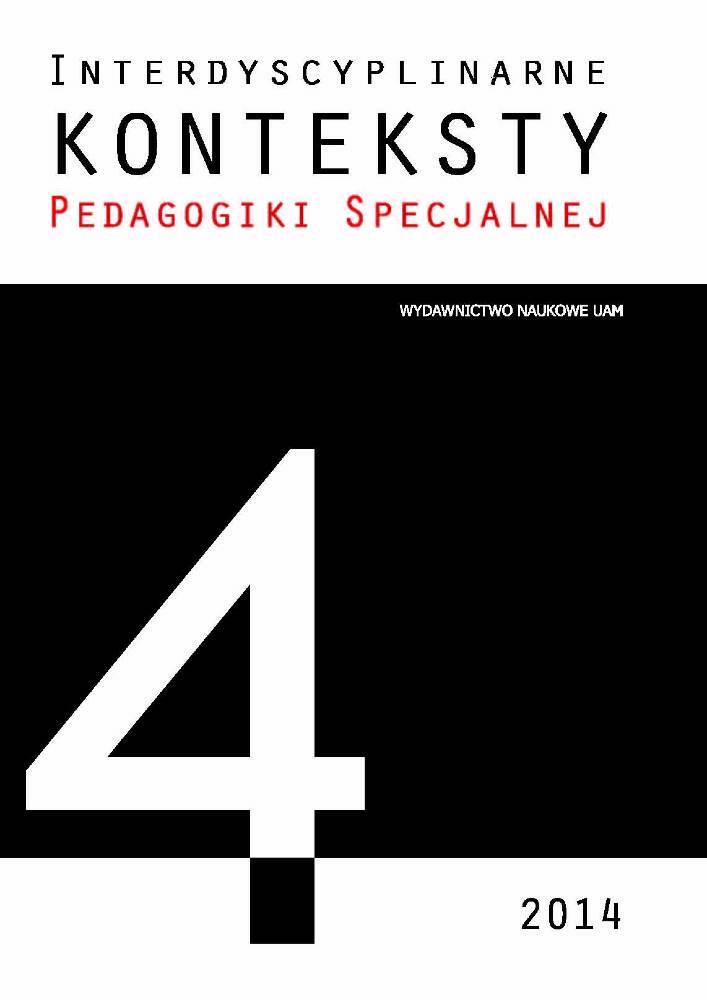Abstract
Self-concept has been an important theoretical construct for children and especially for children with mild/moderate disabilities in the history of special education. This chapter will review the role that self-concept has played in the field of special education and how it has impacted children in the history of schooling in the United States. Definitional models of self-concept will be presented and analyzed in light of the impact of the social outcomes on academic/cognitive progress.
References
BYRNE B.M., SHAVELSON R.J., Adolescent self-concept: Testing the assumption of equiva-lent structure across gender, “American Educational Research Journal”, 1987, 24, p. 365–385.
BYRNE B.M., SHAVELSON R.J., On gender differences in the structure of adolescent self- -concept, paper presented at the annual meeting of the American Educational Research Association, San Francisco 1986(a), April.
BYRNE B.M., SHAVELSON R.J., On the structure of the adolescent self-concept, “Journal of Educational Psychology”, 1986(b), 78, p. 474–481.
CHAPMAN J.W., Learning disabled children's self-concepts, “Review of Educational Research”, 1988, 58, p. 347–371.
CRAIN R.M., BRACKEN B.A., Age, race, and gender differences in child and adolescent self- -concept: Evidence from a behavioral-acquisition, context-dependent model, “School Psychology Review”, 1994, 23, p. 496–511.
CRAVEN R.G., MARSH H.W., DEBUS R.L., Effects of internally focused feedback on en-hancement of academic self-concept, “Journal of Educational Psychology”, 1991, 83, p. 17–27.
FUCHS D., FUCHS L., Inclusive schools movement and the radicalization of special education reform, “Exceptional Children”, 1994, 60, p. 294–309.
GRESHAM F.M., Behavior disorder assessment: Conceptual, definitional, and practical considerations, “School Psychology Review”, 1985, 14, p. 495–509.
GRESHAM F.M., ELLIOTT S.N., EVANS-FERNANDEZ S.E., Student Self-Concept Scale Manual, American Guidance Service, Inc., Circle Pines MN 1993.
GRESHAM F.M., MACMILLAN D.L., Social competence and affective characteristics of students with mild disabilities, “Review of Educational Research”, 1997, 67,
p. 377–415.
MARSH H.W., Self-Description Questionnaire II: A theoretical and empirical basis for the measurement of multiple dimensions of adolescent self-concept: A test manual and a re-search monograph, The Psychological Corporation, San Antonio TX 1990.
MARSH H.W., Self-serving effect (bias?) in academic attributions: Its relation to academic achievement and self-concept, “Journal of Educational Psychology”, 1986, 78,
p. 190–200.
MARSH H.W., Sex differences in the development of verbal and mathematics constructs: The High School and Beyond study, “American Educational Research Journal”, 1989, 26, p. 191–225.
MARSH H.W., The multidimensional structure of academic self-concept: Invariance over gender and age, “American Educational Research Journal”, 1993, 30, p. 841–860.
MARSH H.W., Using the national longitudinal study of 1988 to evaluate theoretic models of self-concept: The Self-Description Questionnaire, “Journal of Educational Psycholo-gy”, 1994, 86, p. 439–456.
MARSH H.W., BARNES J., CAIRNS L., TIDMAN M., Self-description questionnaire: Age and sex effects in the structure and level of self-concept for preadolescent children, “Journal of Educational Psychology”, 1984, 76, p. 940–956.
MARSH H.W., CHESSOR D., CRAVEN R., ROCHE L., The effects of gifted and talented programs on academic self-concept: The big fish strikes again, “American Educational Research Journal”, 1995, 32, p. 285–319.
MARSH H.W., HOLMES I.W., Multidimensional self-concepts: Construct validation of responses by children, “American Educational Research Journal”, 1990, 27, p. 89–117.
MARSH H.W., PARKER J., BARNES J., Multidimensional adolescent self-concepts: Their relationship to age, sex, and academic measures, “American Educational Research Journal”, 1985, 22, p. 422–444.
MARSH H.W., PARKER J.W., SMITH I.D., Preadolescent self-concept: Its relation to self- -concept as inferred by teachers and to academic ability, “British Journal of Educa-tional Psychology”, 1983, 53, p. 60–78.
MARSH H.W., RELICH J., SMITH I.D., Self-concept: The construct validity of interpretations based upon the SDQ, “Journal of Personality and Social Psychology”, 1983, 45,
p. 173–187.
MARSH H.W., SMITH I.D., Multitrait-multimethod analyses of two self-concept instru-ments, “Journal of Educational Psychology”, 1982, 74, p. 430–440.
PIERS E.B., HARRIS D.B., Age and other correlates of self-concept in children, “Journal of Educational Psychology”, 1964, 55, p. 91–95.
SHAVELSON R.J., HUBNER J.J., STANTON G.C., Self-concept: Validation of construct inter-pretations, “Review of Educational Research”, 1976, 46, p. 407–441.
SILON E.L., HARTER S., Assessment of perceived competence, motivational orientation, and anxiety in segregated and mainstreamed educable mentally retarded children, “Journal of Educational Psychology”, 1985, 77, p. 217–230.
SOARES L.M., SOARES A.T., Convergent and discriminant analysis of academic self- -perceptions, paper presented at the meeting of the American Association for the Advancement of Science, Washington D.C. 1982.
STREIN W., Advances in research on academic self-concept: Implications for school psychology, “School Psychology Review”, 1993, 22, p. 273–284.
STREIN W., CAIN P., EDELMAN E., SCHWALB S., Big-fish-little-pond, and other aspects of students' academic self-concepts, paper presented at the meeting of the National Association of School Psychologists, Boston 1989, March.
WIDAMAN K.F., MACMILLAN D.L., HEMSLEY R.E., LITTLE T.D., BALOW I.H., Differences in adolescents' self-concept as a function of academic level, ethnicity, and gender, “American Journal on Mental Retardation”, 1992, 96, p. 387–404.
